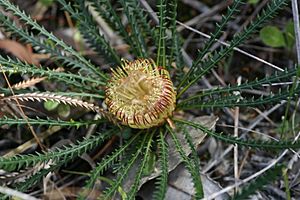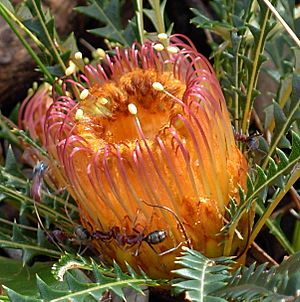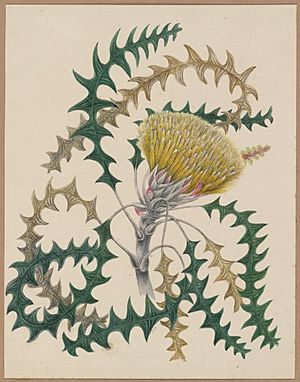Couch honeypot facts for kids
Quick facts for kids Couch honeypot |
|
|---|---|
 |
|
| Banksia dallanneyi at Cottonwood Crescent Reserve, Dianella | |
| Scientific classification | |
| Genus: |
Banksia
|
| Species: |
dallanneyi
|
| Synonyms | |
|
|
Banksia dallanneyi, often called the couch honeypot, is a type of shrub that grows low to the ground. It is found only in Western Australia. This plant has a short stem above the ground. Its leaves are deeply cut, and it produces between 30 and 70 flowers of different colors. The fruit is smooth and shaped like an egg.
Contents
About the Couch Honeypot
The couch honeypot is a shrub that can sometimes grow up to 3 m (9.8 ft) tall. It has a special underground stem that helps it survive fires. The part of the stem above ground is usually quite short.
Leaves of the Plant
Its leaves are 60–200 mm (2.4–7.9 in) long and 2–20 mm (0.079–0.787 in) wide. They grow on a stalk called a petiole, which is 10–120 mm (0.39–4.72 in) long. The leaves are deeply divided into many small sections. There are between 10 and 80 triangular or oblong parts on each side of the leaves. The underside of the leaves is covered with soft, white, woolly hairs.
Flowers and Fruit
The flowers grow in groups of 30 to 70. At the base of each flower group are special leaf-like parts called involucral bracts, which are 15–25 mm (0.59–0.98 in) long. The flowers themselves have a part called a perianth, which can be cream, golden yellow, or pinkish. This part is 20–35 mm (0.79–1.38 in) long. The central part of the flower, called the pistil, is cream, pink, or maroon and is 30–40 mm (1.2–1.6 in) long. The couch honeypot flowers from May to October. After flowering, it produces a smooth, egg-shaped fruit called a follicle, which is 7–13 mm (0.28–0.51 in) long.
How it Got its Name
The couch honeypot was first officially described in 1845 by a scientist named Carl Meissner. He originally named it Dryandra lindleyana.
Later, in 1996, another scientist named Alex George identified five different types, or subspecies, of this plant. He also found two varieties within one of these subspecies. These different types were based on features like the shape and size of their leaf parts and the length of their stems.
In 2007, two scientists, Austin Mast and Kevin Thiele, decided to move all Dryandra species into the Banksia group. Since there was already a plant called Banksia lindleyana, they had to give the couch honeypot a new name. They chose "dallanneyi," which is an anagram (a word made by rearranging the letters) of "lindleyana."
Today, the different types of Banksia dallanneyi are known by these names:
- Banksia dallanneyi subsp. agricola
- Banksia dallanneyi subsp. dallanneyi
- Banksia dallanneyi subsp. media
- Banksia dallanneyi subsp. pollosta
- Banksia dallanneyi subsp. sylvestris
Where it Lives
The Banksia dallanneyi grows in Western Australia. You can find it on flat areas and small hills. It grows in many different kinds of soil between the cities of Geraldton and Albany.
Its Place in Nature
Scientists have studied how climate change might affect this plant. They found that the areas where it can grow might shrink by 30% to 80% by the year 2080. This depends on how much the climate changes.



